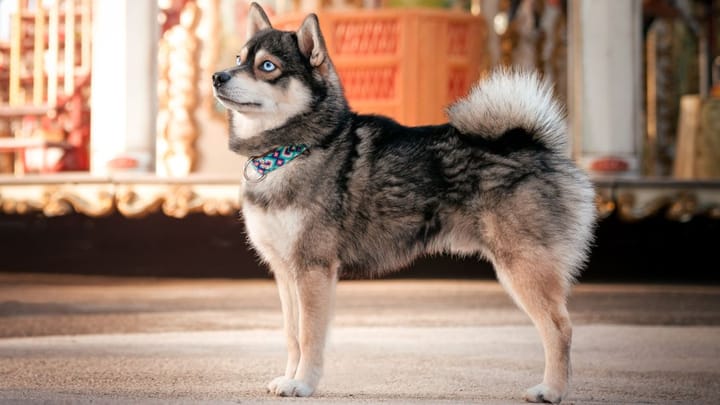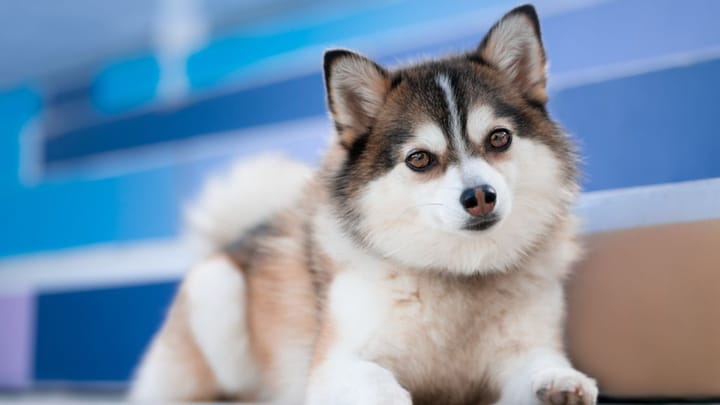Pomsky
Crossbreed: Pomeranian or miniature Spitz × Husky


The Pomsky is a cross between a Pomeranian and a Siberian Husky. Created in the United States in the early 2000s, the Pomsky is not yet recognised by the main cynological organisations, such as the Fédération Cynologique Internationale (FCI) or the American Kennel Club (AKC). But that doesn't make them any less popular!
There are five different sizes of the German Spitz dog, ranging from the smallest, the Pomeranian, to the largest, the Keeshond. They are all cheerful, jovial and affectionate but reserved around strangers, which makes them good guard dogs. They are intelligent and docile, making them easy to train and suitable for many households, especially those with children.
Once seen in sled-dog competitions, Siberian Huskies are now more often kept as pets. These striking, gentle dogs suit those drawn to primitive breeds. Friendly with all, they make poor guard dogs. Highly independent and possessing a strong prey drive, Huskies require commitment and understanding. Choosing one as a companion should be a well-considered decision.

Pomeranian or miniature Spitz
There are five different sizes of the German Spitz dog, ranging from the smallest, the Pomeranian, to the largest, the Keeshond. They are all cheerful, jovial and affectionate but reserved around strangers, which makes them good guard dogs. They are intelligent and docile, making them easy to train and suitable for many households, especially those with children.

Husky
Once seen in sled-dog competitions, Siberian Huskies are now more often kept as pets. These striking, gentle dogs suit those drawn to primitive breeds. Friendly with all, they make poor guard dogs. Highly independent and possessing a strong prey drive, Huskies require commitment and understanding. Choosing one as a companion should be a well-considered decision.
|
Life expectancy |
The Pomsky has a life expectancy of between 12 and 15 years |
|
Temperament |
|
|
Size |
Small
|
|
Adult size |
Female
Between 12 and 16 in
Male
Between 12 and 16 in
|
|
Adult weight |
Female
Between 13 and 24 lb
Male
Between 13 and 24 lb
|
|
Coat colour
|
Black White Brown Red Sand |
|
Type of coat
|
Long |
|
Eye colour
|
Blue
Brown
Odd-eyed
|
There are different types of Pomskies depending on whether the parents are purebred (Siberian Husky and Pomeranian) or crossbred themselves. They are classified into different categories: F1, F2, F3.
Pomskies are small or medium-sized, but their weight can vary, even within the same generation. This depends on the genes they inherit from the Husky and the Pomeranian.
F1 (First Generation Pomsky)
Description: An F1 Pomsky is the result of a cross between a Siberian Husky and a Pomeranian. It is recommended that both parents be registered in the Kennel Club. F1 Pomskies are considered to be the strongest and healthiest. Breeding new generations reduces the health and quality of the dog.
Weight: F1 Pomskies can vary greatly in size depending on the genetic influence of the parents, weighing between 26 and 44 lbs (12-20 kgs).
F2 (Second Generation Pomsky)
Description: An F2 Pomsky is the result of crossing two F1 Pomskies.
Weight: They can weigh from 15 to 24 lbs (7-11 kgs). But once again, greater variations are possible.
F3 (Third Generation Pomsky) and beyond
Description: An F3 Pomsky is the result of crossing two F2 Pomskies, or an F2 Pomsky with an F1 Pomsky.
Beyond that, there can also be a cross between 2 F3 Pomskies.
Weight: Depending on the breeder's selection, they can weigh between 7 and 13 lbs (3-6 kgs).
F1B (Backcross Pomsky)
Description: An F1B Pomsky is the result of crossing an F1 Pomsky with a purebred Siberian Husky or Pomeranian.
Weight: The size of an F1B Pomsky varies greatly depending on whether the cross is with a Husky or a Pomeranian. An F1B Pomsky can weigh between 10 and 35 lbs (5-16 kgs).
More details about the Pomsky
Pomsky: Origins and history
The Pomsky's exact origins are a little unclear, with no consensus on when and where this cross was first created. Nevertheless, it was in 2012 that Tressa Peterson, head of the Apex Pomskies kennel, and Joline Phillips, head of the Arctic Design Pomskies kennel, jointly laid the foundations for the creation of the Pomsky. They crossed a Pomeranian male with a Siberian Husky female, creating what is now known as the Pomsky. Pomskies have become increasingly popular all around the world. In the first year of their existence, the number of breeding kennels in the US rose from a handful to over thirty.
Subsequently, these dogs gained in popularity in the rest of the world, with a growing demand for dogs with unique looks and charming personalities.
It's important to note that the Pomsky is a so-called "designer dog", and its characteristics can vary depending on the genetics inherited from the two parent breeds. Pomsky breeders work to stabilise the desired characteristics, but the inherent variability in cross-breeding persists.
Pomsky: Characteristics
Pomsky: Behaviour
Training a Pomsky
Both parent breeds tend to be a little stubborn. Training and socialisation should start as early as possible, and you'll have to be patient! Nevertheless, if you are consistent and use positive training methods, the Pomsky is generally easy to train.
Pomsky: Lifestyle
Breed compatibility Pomsky
Pomsky: Shedding
Heavy !
Both the Pomeranian and the Siberian Husky have thick double coats, so expect your Pomsky to be quite fluffy! Depending on the length of your Pomsky's coat, you'll need to brush it several times a week or daily. Get your hoover ready, because Pomskies shed a lot!
Pomsky: Health
Pomskies are robust little dogs.
Pomskies have thick double coats, so will need special attention when the weather is hot.
Pomskies are well-adapted to cold weather.
Pomskies have a tendency to put on weight, so it's important to feed them a high-quality diet.
- Allergies
- Hip dysplasia
- Patellar dislocation (dislocated knees)
- Eye problems
- Epilepsy
- Heart disease
- Collapsing windpipe
- Dental problems (make sure you brush their teeth regularly!)








